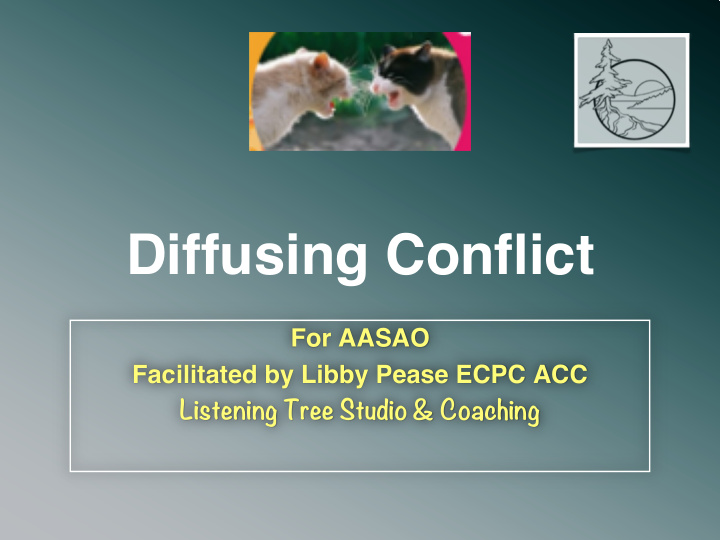



Diffusing Conflict For AASAO Facilitated by Libby Pease ECPC ACC Listening Tree Studio & Coaching
Warming Up • What is important about this presentation for you personally? • How will you know that this presentation has been a benefit to you? • Share one unique thing about yourself. 2
Survey Thank you to all who filled out the survey! • Top 3 challenging emotions • Skills Requested • Fears 3
Skills What is behind the feeling?
Feelings and Values • Feelings and values are linked • If our values have been threatened our reactions are quick and can be intense • If our values have been validated our reactions are calmed and we feel understood 5
Validation & Active Listening When individuals don’t feel heard or understood they will increase efforts to be heard and understood! • First step to deescalation is to seek to understand and to truly hear what is behind the emotion • Validating the feelings does not equal agreeing with their point of view • Active Listening focuses on the individual and not on our individual feelings - Empathy 6
Active Listening More than just your ears!
Question Formulation Matters Exercise: Why/ What How you formulate a question matters! Break off into pairs - One person will relay a story about something that went well in the past week or two. The other person will only ask WHY! Switch Partner will now only ask questions starting with What or How questions 9
Calm is Contagious
Gentle Refusals “Givers set limits because takers rarely do.” Irma Krutz Gentle Refusal is a skill that is part of the Limit Setting Model that allows you to say NO in a gentle and caring way and inviting the individual to continue the conversation in a more constructive way. 11
Structure of Gentle Refusals Three main parts to Gentle Refusals 1. Validation/ Reflection / Active Listening 2. Setting of Limits/ Refusal 3. Offering the invitation Empathy, seeking to understand are the condiments! 12
Structure Continued 1. Validation/ Reflection / Active Listening In the top Bun of your limit setting you want to let the individual know that you hear what is behind their anger, frustration or demand. This is key. If you forget this element you are missing the empathy and understanding that will help bring the emotionality down and increase the ability to problem solve. “I see that you’re frustrated because you can’t take your dog home today.” 13
2. Setting of Limits/ Refusal In the patty part of your Gentle Refusal burger you are focusing on your limits and the reason for them. You need to be clear with this and also concise. Know the real reason behind refusing them other then they have made you uncomfortable. “I will not be sending your dog home with you today, because we have to complete our investigation and assess the dogs health.” 14
3. Offering the invitation This is the bottom bun of your Gentle Refusal Burger. Communicate clearly to what you CAN do or are willing to do within your policies. This is an invitation and your tone and body language need to reflect this as an authentic gesture to continue in a more constructive way. “However lets talk more and see what we can do to help you with the requirements we presented to you.” 15
To Be Effective Using the Limit Setting Model Effectively To use this skill to the full advantage you must: • Understand your own feelings and appreciate why the limits are being set • State your position clearly in a non-blameful, non-judgemental way • Be prepared to deal with the feeling generated by setting your limits and saying no After the Limit Setting, ACTIVE LISTEN to deal with the caller’s feelings which may have arisen from asserting your limits. If you omit this step you will ‘hit and run’, which may leave the caller with a host of new feelings to deal with. 16
Two strikes, you’re out! Step One: Draw the line in the sand Step Two: Respect and enforce that line 17
Practice Gentle Refusals Three main parts to Gentle Refusals 1. Validation/ Reflection / Active Listening 2. Setting of Limits/ Refusal 3. Offering the invitation Empathy, seeking to understand are the condiments! 18
Expectations Look back at your original Warm Up questions. • How have you benefited from this training? • What has been most helpful? 19
Life Coaching Recognizing the drain and pain of burnout and compassion fatigue? Let me walk with you to process the pain and rekindle your passions, so you can create self-care and work flow that replenishes you! Free Discovery Session Fill out your contact information at the bottom of your Feedback form. 20
Libby Pease ECPC ACC Office: 226-838-9772 libby@listeningtreestudio.ca www.listeningtreestudio.ca 21
Recommend
More recommend